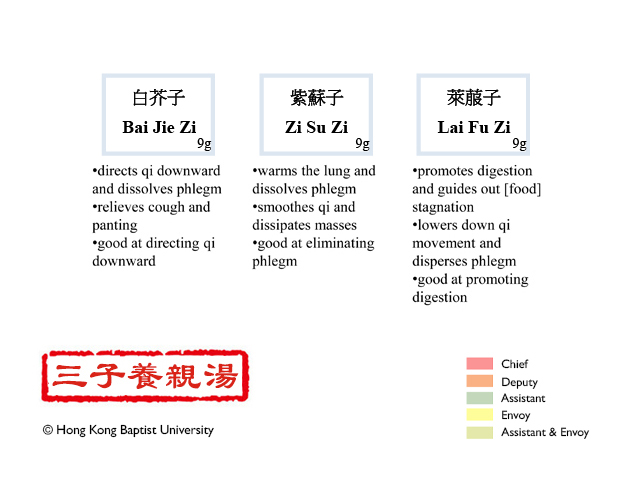|
|
 Chinese Medicinal Material Chinese Medicinal Material
|
| 【Chinese Name】 |
三子養親湯
|
| 【Phonetic】 |
San Zi Yang Qin Tang
|
| 【English Name】 |
Three-Seed Filial Devotion Decoction |
| 【Classification】 |
Phlegm-expelling formulas |
| 【Source】 |
《Effective Formula》Jie Xiao Fang《皆效方》recorded in《Essentials of Expanded Miscellaneous Diseases》Za Bing Guang Yao《雜病廣要》 |
| 【Combination】 |
Perillae Fructus (Zi Su Zi) 9g, Brassicae Junceae Semen (Bai Jie Zi) 9g, Raphani Semen (Lai Fu Zi) 9g |
| 【Method】 |
Slightly dry-fry the three medicinals and then pound them into pieces. Wrap it up in a cotton cloth and decoct mildly. Take the decoction frequently. |
| 【Action】 |
Directs qi downward and smoothes diaphragm, dissolves phlegm and promotes digestion. |
| 【Indication】 |
San Zi Yang Qin Tang is applicable to patients with phlegm congestion, counterflow qi, and food stagnation. The symptoms include coughing with labored breathing, copious phlegm, chest obstruction, less food intake, difficulty with digestion. The tongue coating is white and greasy and the pulse is slippery. |
| 【Pathogenesis】 |
San Zi Yang Qin Tang is used to treat cough, counterflow qi and stuffiness due to phlegm obstruction in senior patients. When people get old, the center qi becomes deficient. It becomes hard to receive and transport food which leads to food stagnation and phlegm accumulation. Phlegm accumulates in the lung and stomach leading to the above-mentioned symptoms. The tongue and pulse characteristics indicate cold and phlegm obstruction. The therapeutic principle is to warm the lung and dissolve phlegm, direct qi downward, and promote digestion. |
| 【Application】 |
1. Essential pattern differentiation
San Zi Yang Qin Tang is a common formula applicable to patterns of phlegm congestion, counterflow qi, and food stagnation. It is especially good for senior patients. This clinical pattern is marked by cough with copious phlegm, less foof intake and chest pi white and greasy tongue coating, slippery pulse.
2. Modern applications
This formula may be used in the following biomedically defined disorders when the patient shows signs of phlegm accumulation, adverse flow of qi, and food stagnation: intractable cough, chronic bronchitis, bronchial asthma, and pulmonary heart disease.
3. Cautions and contraindications
It is recorded in the original book that the three medicinals should be dry-fried slightly and then be smashed in order to reduce the stimulation to the larynx and throat and the lung and stomach. This is especially important for lai fu zi because its property will change to sink downward after being fried. When the medicinals are being smashed, it is good for the components to dissolve out. In terms of administration, it is better to take the decoction frequently in small amounts each time, just like sipping tea. |
|
|

|




